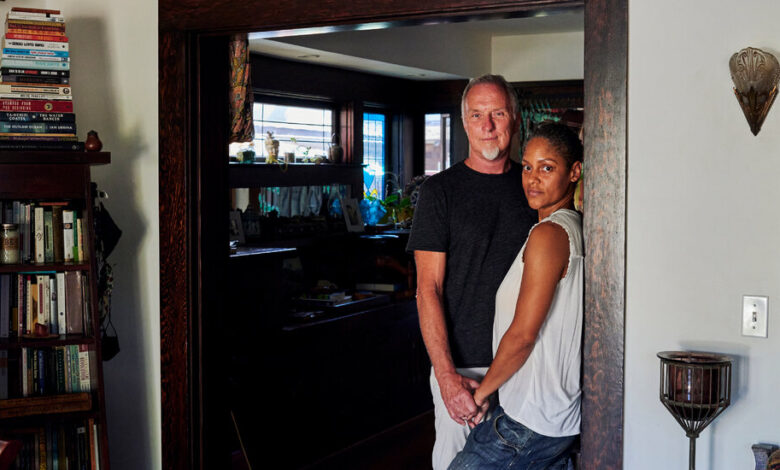Is There Racism in the Deed to Your Home?

Last year, to celebrate the centennial of their charming Craftsman home, Kyona and Kenneth Zak repainted it in historically accurate colors — gray, bronze green and copper red. They commissioned beveled-glass windows to complement the original stained glass. And they visited the San Diego County Recorder, to have a line drawn through a sentence in their deed that once would have prohibited Ms. Zak, who is Black, from owning the home.
“I’ve referred to it as the ultimate smudge stick to the house,” said Ms. Zak, an ayurvedic health counselor and yoga therapist, drawing parallels to the Indigenous practice of purifying a place by burning sacred herbs.
Buried in the fine print of the Zaks’ deed was a racial covenant, a clause that barred anyone “other than the White or Caucasian race” from owning the home. For much of the 20th century, it was common practice to insert such restrictions into deeds. The covenants targeted people who were Asian, Latino and Jewish, but especially those who were Black.
Racial covenants were used across the United States, and though they are now illegal, the ugly language remains in countless property records. In Seattle and Boston, Los Angeles and Long Island and beyond, racism doesn’t just hit close to home — it can be part of it. Homeowners may not even know that their deed includes a covenant; it’s easily missed in the slew of paperwork that comes with buying a home.
Now, a number of states are enacting laws enabling homeowners to reject and more easily eliminate racial covenants. But covenants and other racist policies of the past have left a deep legacy of inequality, and many believe that merely renouncing the words is no substitute for doing the hard work to undo their impact.
The Zaks live in Mission Hills, an affluent neighborhood in San Diego that was developed in the early 20th century, at a time racial covenants were embraced and promoted by real estate agents, developers and the federal government.
In 1917, the Supreme Court struck down racial zoning laws that were designed to keep cities segregated, according to Richard Brooks, visiting professor of law and senior research scholar at Yale Law School and co-author of the book “Saving the Neighborhood: Racially Restrictive Covenants, Law, and Social Norms.” Racial covenants, though, could be implemented on an individual or neighborhood level — less centralized than laws, but not necessarily less powerful.
“Private action was thought to be not subject to constitutional constraints,” said Carol Rose, G. B. Tweedy professor emeritus at Yale Law School and Lohse professor of law emeritus at the University of Arizona, and Mr. Brooks’ co-author. High-end real estate developments built in the early 20th century, such as Palos Verdes Estates in Los Angeles, included racial covenants from the beginning, she said. In older areas, homeowners went door-to-door to convince neighbors to add the covenants to deeds.
In 1927, the National Association of Real Estate Boards — now the National Association of Realtors — championed racial covenants, creating a model clause that was inserted into countless deeds. It read, in part: “No part of said premises shall be sold, given, conveyed or leased to any negro or negroes.” (Late last year, in the wake of the racial justice movement sparked by the murder of George Floyd at the hands of police officers, the association issued a formal apology for its past racist actions.)
The Federal Housing Administration, which was created in the 1930s to insure home mortgages, also all but required racial covenants to guarantee loans, including those for developments like Levittown, a community of mass-produced tract homes on Long Island that opened in the late 1940s and where only “members of the Caucasian race” were allowed to live.
In 1948, the Supreme Court ruled that racial covenants couldn’t be enforced — though not that they couldn’t be used. Twenty years later, the Fair Housing Act finally made racial covenants illegal. But the words and their profound effect on the housing landscape have lived on.
“Enforcement in court is just one way covenants facilitated segregation, and not even the most important way,” Mr. Brooks said. “The covenant gave a signal. Who should we bring to this neighborhood? Who will get financing? Who will get insured?”
Just by their presence, covenants communicated to white buyers that living in mixed neighborhoods was a risk to their home values, Mr. Brooks said.
A lawyer turned novelist, Mr. Zak dug his 10-page deed out of the roughly 100-page pile of closing documents for his home after reading a news article about covenants in 2019. (When he read the article, he said, “You know what? I thought I saw that language in our document”) An attached rider announced that discriminatory clauses were not enforceable. “That didn’t seem like enough for us,” he said. “Now it’s redacted and rejected.” On their updated deed, the covenant is visible, but crossed out.
Making such changes wasn’t always possible, said Kirsten Delegard, co-founder of Mapping Prejudice, a project that has been identifying and mapping racial covenants in the twin cities of Minneapolis and St. Paul.
“Until very recently, it’s been a huge ordeal,” she said. “You have to go to court, you have to hire a lawyer. It’s very expensive.”
Covenants have historically been difficult to remove because they “run with the land” — in other words, they’re considered a permanent feature of the property. “It’s like a setback; you can’t just redact that on your own,” Ms. Rose said. “You’ve got to have an affidavit, you have to have this, that. A number of people in the past have given up.”
Within the past three years, at least eight states have passed laws aimed at making it easier — though not necessarily easy — for homeowners to remove racial covenants from deeds. Another half dozen, including New York and California, have bills pending. The Zaks gladly paid a $95 fee to get rid of their covenant; California’s proposal would eliminate the cost.
“We’re trying to make it universally free and seamless so a homeowner can right a wrong,” said Kevin McCarty, a state assemblyman for Sacramento, who this year co-introduced a bill based on one that Gov. Arnold Schwarzenegger vetoed in 2009.
Mr. McCarty, who is half Black, encountered a racial covenant when he bought his first home. He didn’t have it removed, he said. At the time, he didn’t even know it was possible.
“Look, is this going to address inequities in homeownership for Black Californians?” he said. “No, it won’t. Nonetheless, I think the words don’t belong there. They’re harmful. To me it’s akin to leaving a sign above a water fountain that says ‘White Only.’ ”
Nobody knows how many deeds have racial covenants attached to them, because public record-keeping is so localized and the language can be buried deep. Mapping Prejudice had to create a search tool to comb through 10 million images of public documents from Hennepin County in Minnesota, Ms. Delegard said. It found 30,000 “suspects,” which were uploaded to a crowdsourcing platform so community members could help identify covenants.
But location, not just the number of covenants, made the restrictions effective, Ms. Rose said. Racial covenants were often strategically added to deeds in “buffer” areas adjacent to Black neighborhoods. Along with redlining, a federal practice of refusing financing in minority neighborhoods that were outlined in red on maps, they were part of a system that denied Black people the freedom to purchase a home of their choosing — and often, any home at all. Minorities were often confined to neighborhoods with unequal public services and education, and consequently deprived of much of the wealth that white buyers accumulated through appreciating home values.
Increasingly, homeowners want to renounce their racial covenants. Last year, Just Deeds, a coalition of real estate and title professionals, attorneys, community members and city staff who are providing pro bono help with discharging covenants, launched in the Minneapolis area. As a decentralized effort, the group doesn’t have a firm count of how many homeowners it has helped. But when Just Deeds became active within the city of Minneapolis, it got more than 700 applications in the first week, said Maria Cisneros, a founder of the coalition and city attorney for the suburb of Golden Valley.
“The more publicity we get, the more demand there is,” she said.
Some housing experts say that renouncing racist language isn’t enough — and organizers agree.
“I would never speak against or minimize things that people do to register that they have some level of displeasure, at the minimum, around these kinds of things,” said Elaine Gross, president of ERASE Racism, a Long Island organization that promotes racial equity. “I do think that is important. Would I say that it’s the most important action that needs to be done? No.”
Projects like Just Deeds and Mapping Prejudice say they aim not to just change records, but minds.
“There’s this tendency for people to say, ‘I found this horrible thing and I’m going to get rid of it,’ ” Ms. Delegard said. “I think we have to constantly be pushing the fact that we can’t be content with virtue signaling.”
The Zaks are mindful that Mission Hills is still mostly white, and have been trying to raise awareness of racial covenants. They’ve used their experience to talk to neighbors about institutionalized racism.
“We’ve had some interesting, uncomfortable conversations,” Mr. Zak said. “Uncomfortable but necessary.”
For weekly email updates on residential real estate news, sign up here. Follow us on Twitter: @nytrealestate.






